
Four wake-up taps on my shoulder finally set in motion "The Butterfly Project." I went from thumping lime green caterpillars that were eating my parsley to growing parsley, carrots, fennel and dill exclusively for Swallowtail caterpillars to eat. This year I created a sanctuary for butterflies to feed and procreate. Here’s my story.
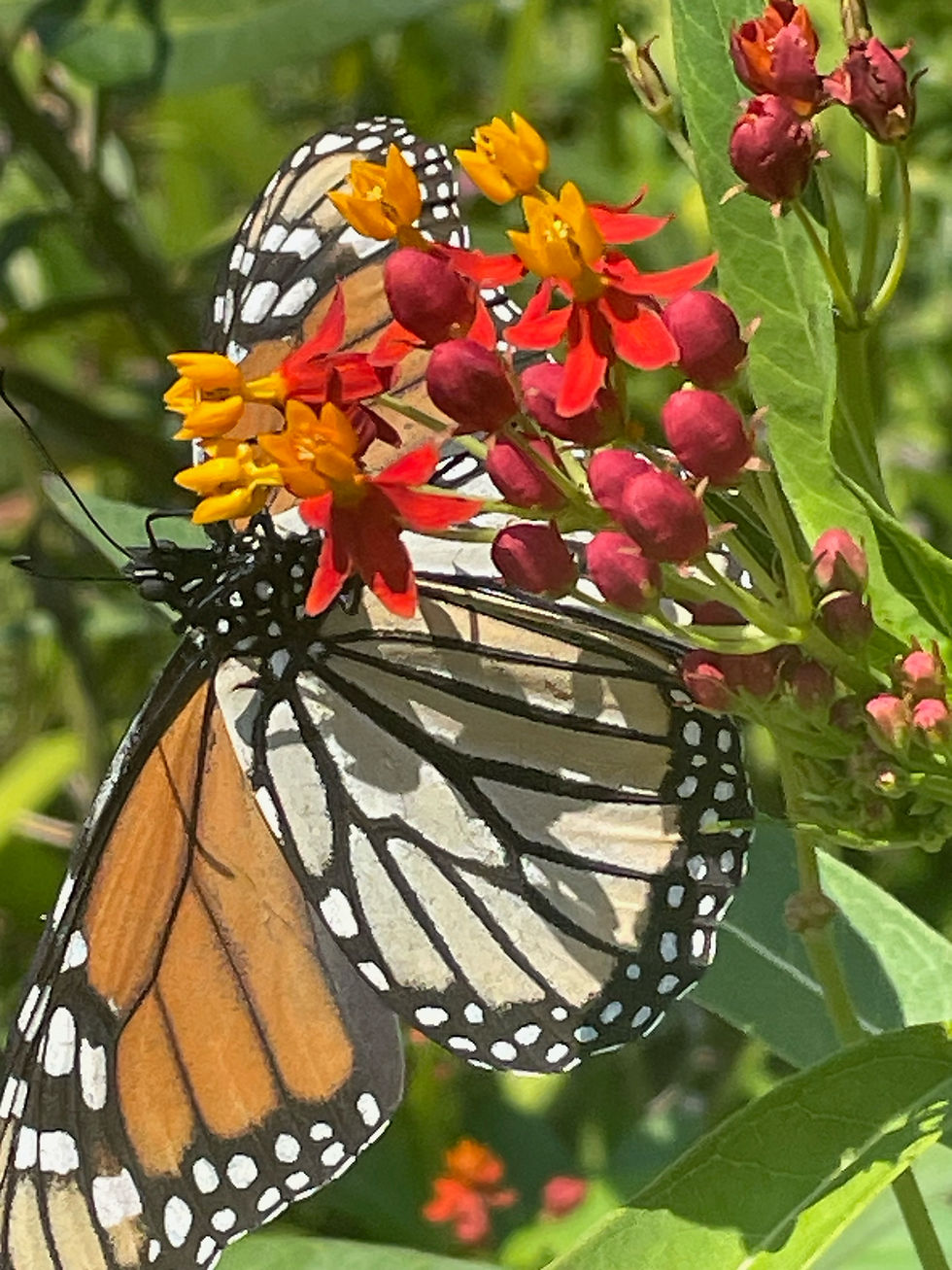
Wake-up tap #1: Monarchs Calling
In early February 2020, just before the Covid-19 virus shut down international travel, I went to San Miguel de Allende, Mexico, with a group of painters under the tutelage of Heather Sink, a Beaufort plein art painter.
In the Mexico City transit lounge I met an American woman traveling to see the Oyamel Fir Tree where monarchs hibernate and wake in a storm of flapping wings, drying them in concert for the long, return journey north. Sounded cool but I was a bit perplexed. Why would someone buy an international plane ticket from the U.S. to Mexico just to sit under a tree?
On the other hand, her endeavor did capture my fantasy and I thought about her often in the days ahead. She inspired me to read about monarch migration when I returned home and to write a poem, “Monarch’s Calling” (See end of blog.)
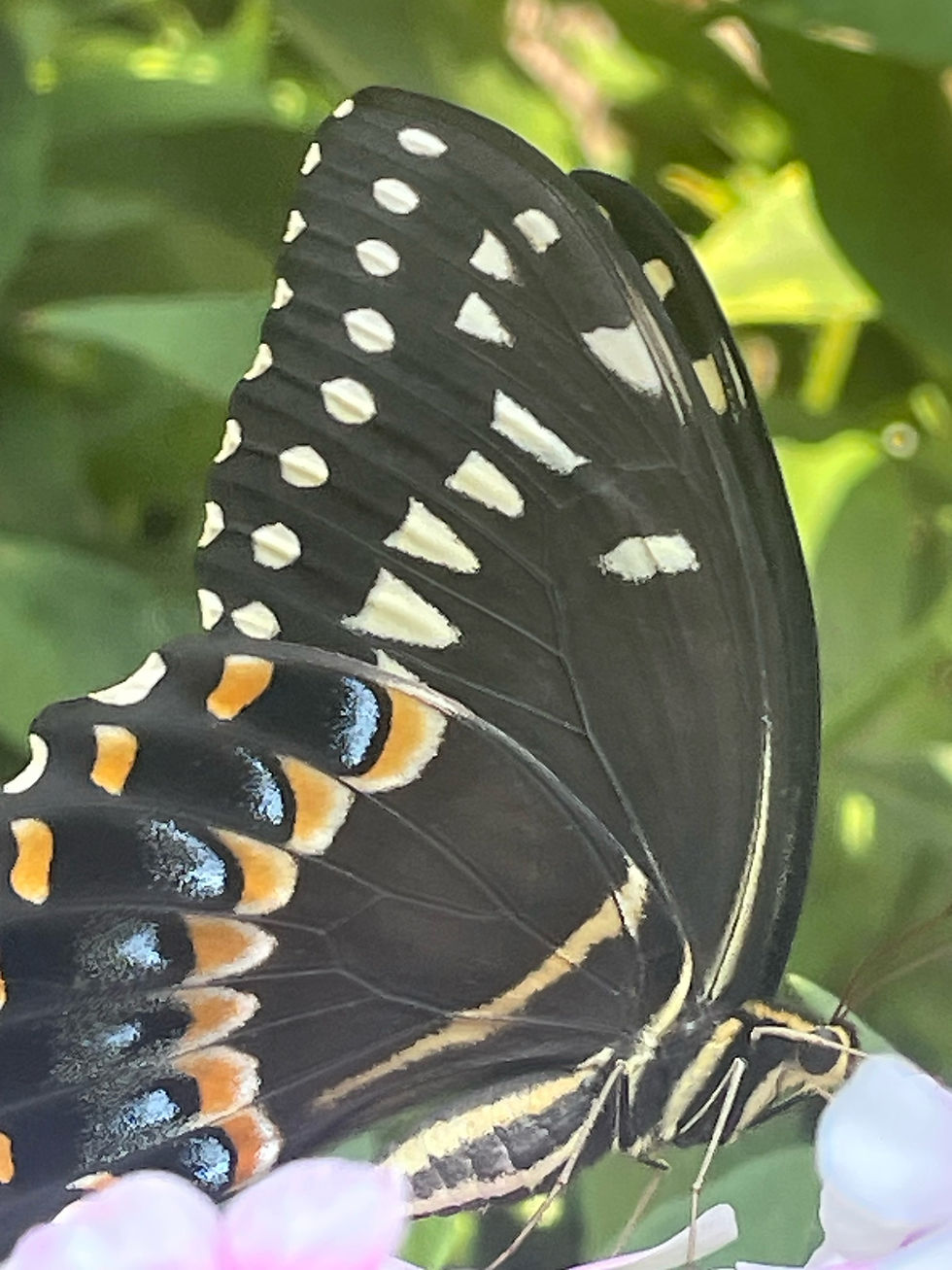
Wake-up tap #2: The Swallowtail Midwife
The next summer, 2021, I called my painter friend Brenda Behr to thank her for a book she sent to me. During our conversation, she asked me to hold the phone as she was filming the birth of a Swallowtail in her kitchen. I had always delighted in the sight of a butterfly, but I was beginning to see that some people took butterfly watching more seriously than I.
As we talked, Brenda sent me live photos and a video clip. I was awestruck by her kitchen filled with jars of branches holding clutches of chrysalis –a butterfly nursery- and wondered if I might also plant a patch of fennel to lure swallowtails to my garden. If she had not sent me the book which led to my calling her that particular day, then I would have missed one of the most fascinating things about my friend-her passion for expanding the population of swallowtails in Eastern North Carolina. I wrote about this in a previous blog.
When I am deeply affected by an experience, it often inspires me to write a poem. I wrote the poem, Swallowtail Midwife, about Brenda and her butterflies. (See end of blog.)
Wake-up Tap #3 Importamce of native plants to survival
In 2022 I learned about native plant gardening from reading a book by Doug Tallamy called Nature’s Best Hope. Tallamy describes how wildlife populations are in decline because the native plants they depend on are fast disappearing. His compelling books and on-line videos have inspired a grassroots approach to conservation.
Tallamy takes a novel approach: Through the initiatives of private individuals, homeowners can turn their yards into conservation corridors that provide wildlife habitats. According to Tallamy, nature’s best hope is me. If I plant natives, I will create a nectar buffet and host plant harbors for butterfly nurseries. If I convince my neighbors to also plant natives, then we will create a corridor where the pollinators can feed and lay eggs as they travel across our town. Together, across a state and nation, we can create Tallamy’s concept of a Homegrown National Park.

My budding awareness came with perfect timing because we were selling our house and renovating a house and garden two blocks away. I would have a clean slate for creating a pollinator garden. Fortunately, the Beaufort Garden Club hosted several experts during 2002/2003 to talk about native plant gardening and alternatives to pesticides and commercial fertilizers. The garden club also sponsored a county-wide symposium featuring Barbara Sullivan to talk about her book, Climate Change Gardening for the South.
Sullivan told the audience about her magical garden in Wilmington, NC, that attracted visitors and events. Her garden was filled with non-native, exotic and tropical plants. She came to realize that an important cause of our environment’s dire state is diminished natural habitats and gardening practices. She then made the painful decision to rip out her beautiful garden and start over, learning about native plants and using them to replace the exotics which hold no value for our pollinators. The audience was inspired by Sullivan’s story.

As renovation on our house began, I read furiously, studied the site, and made a plan. I first considered planting beneficial native trees. It’s a small gardening space but I love trees. I wanted to maximize sun for the perennial flowers but also wanted shade for tranquility. I did some reading on coastal NC native trees in regard to what is already in the backyard space and what I want to achieve.
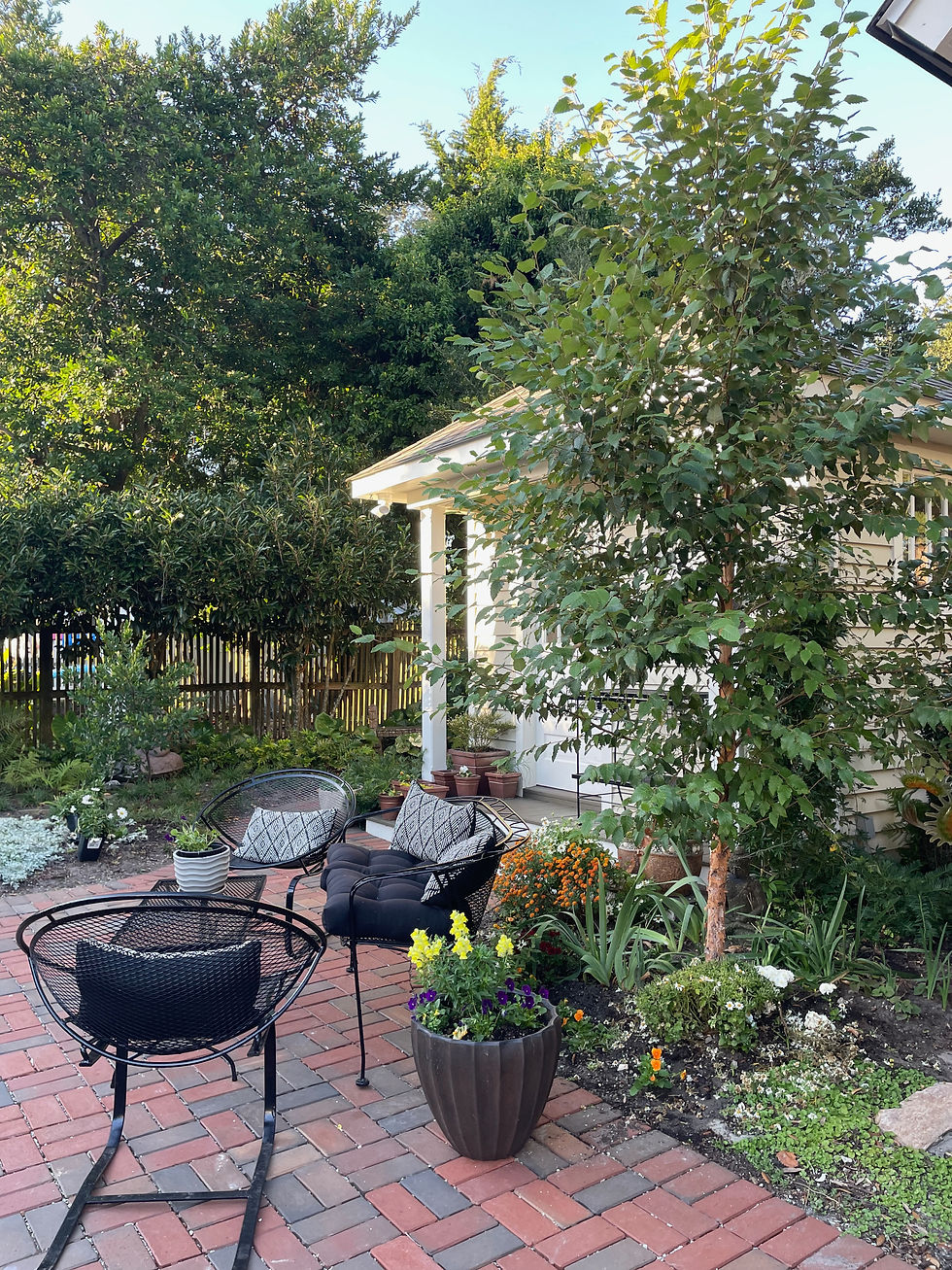
There is a tall stand of three Carolina Cherry Laurels along my left back fence. These are evergreen, providing a year-round green backdrop, and in the winter the cherry laurels are covered with berries that the birds love. Along the back fence, there is a wax myrtle, native yaupon, and a live oak, all beneficial hosts for birds and insects. I planted two additional native cherry laurels and one of my favorite trees, a river birch, which is also native to our region. All of these trees are hosts for abundant bugs and butterflies. I planted one non-native tree, a Chinese maple, that is a family heritage tree. As Barbara Sullivan says, “You may decide to keep or plant a few non-natives, but do so sparingly.”
Wake-up Tap #4 An Art Exhibit
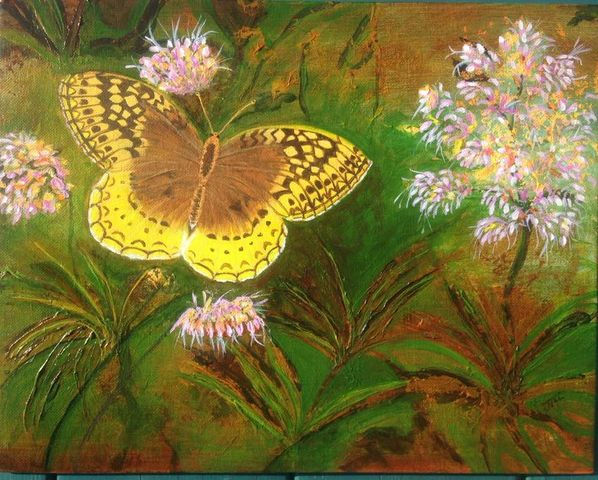
Each February our local arts council sponsors a gigantic art event called “Art from the Heart.” This year, 2023, Carteret Writers added a new feature, Ekphrastic Poetry, where poets write about works of art. Carteret Writers members were invited to come for a private viewing to look at the paintings, and write a poem about one or two that inspired us. The poetry was mounted along-side the painting before the opening of the show. During the event, visitors were provided ballots to vote for their favorite poems. My poem, Butterfly Lessons, inspired by Jill Harner’s painting of a Great Spangled Fritillary, won first prize. (You may read the poem at the close of this blog.)
Having begun my quest to identify pollinator plants I was curious to know the name of this butterfly and the plant in her painting. I contacted the artist who is a close friend and asked her. She told me that the butterfly was a Great Spangled Fritillary and that the plant was Joe Pye Weed. She had seen it on a trip to Northern California. I looked up information on the butterfly and the plant. I read that it takes nectar from the Joe Pye Weed but requires wild violets for laying eggs and feeding the caterpillar.
As I read about the Great Spangled Fritillary I learned that butterflies take nectar from a range of native plants, but require a host plant to procreate. Sadly, after all that study, and the quick planting of some wild violets, I learned that this butterfly is not found in coastal NC. Fortunately, another variety, the Gulf Fritillary, is present in coastal NC.
I have always delighted in the sighting of a butterfly, but knew not their names nor needs. I realized that by planting my garden for specific butterflies I could give a delightful focus for my goal of creating a pollinator garden. My garden would have the dual purpose of learning about butterflies and serving them. In the late summer months of August and September 2022 I studied my back garden space. I saw neither birds nor butterflies. I was starting at zero.
Staking out the site, I identified an area that received all day sun. I decided to make maximum use of the space for providing nectar and host plants. I had a lot to learn and a plan to sketch. As my first season of butterfly gardening came to a close in early November 2023, I came to agree with Vladimir Nabokov who said, “Literature and butterflies are the two sweetest passions known to man.”
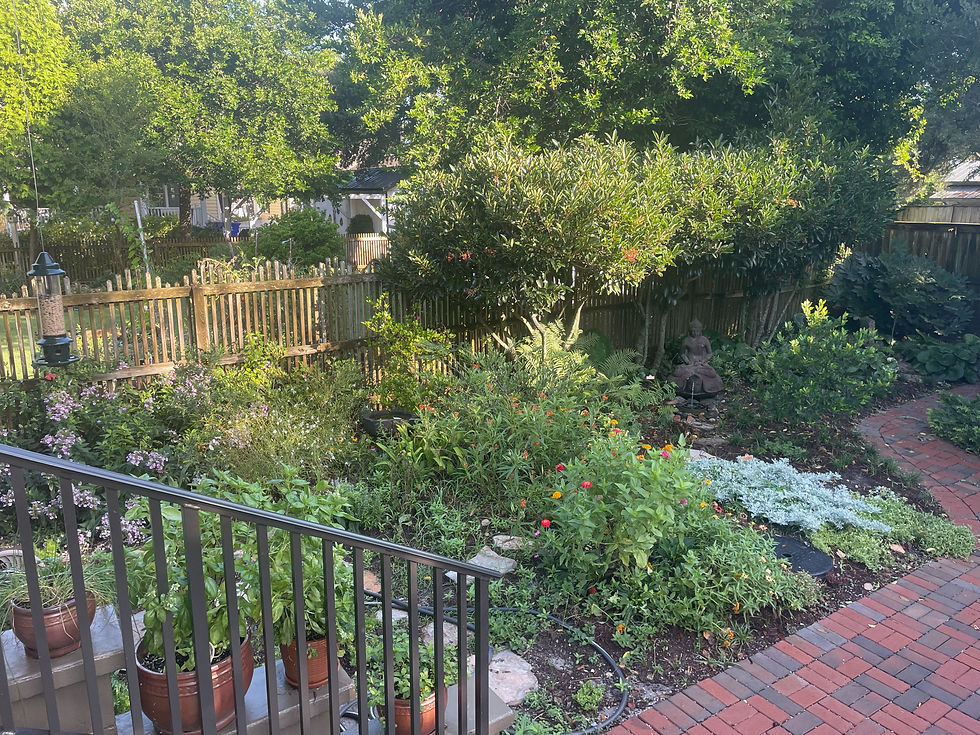
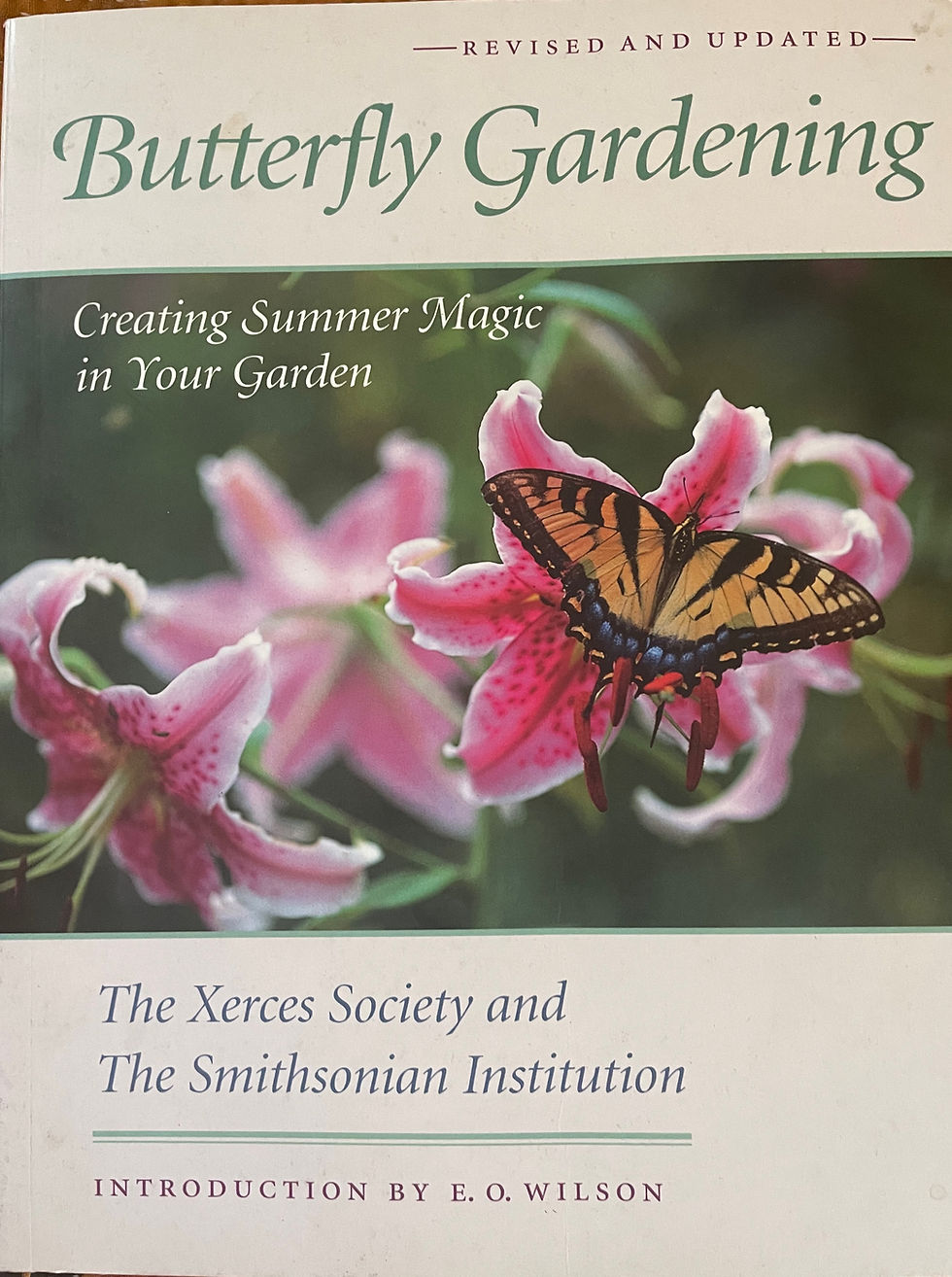
My Butterfly (Lepidoptera) Project
I started my project by reading a book, Butterfly Gardening, written by the Xerces Society and the Smithsonian Institution with an introduction by the great entomologist, E.O. Wilson. Wilson wrote, “…mysterious and little known organisms still live within reach of where you sit. Splendor awaits in minute proportions.” Wilson described butterflies and moths as the flowers of the air.” That’s exactly what I wanted to achieve-flowers on the ground and in the air.
Here are a few things I learned
There are 750,000 species of insects. These small creatures, along with the flowering plants, compose the environmental foundation on which human life depends. Insects manufacture and turn the soil, consume dead plants and animals, provide food as prey for other creatures (e.g. birds require hundreds of caterpillars to feed their babies), pollinate and disperse seeds, and distribute vital nutrients through the ecosystem. If we take away insects, the terrestrial habitats will collapse and soon after human life.
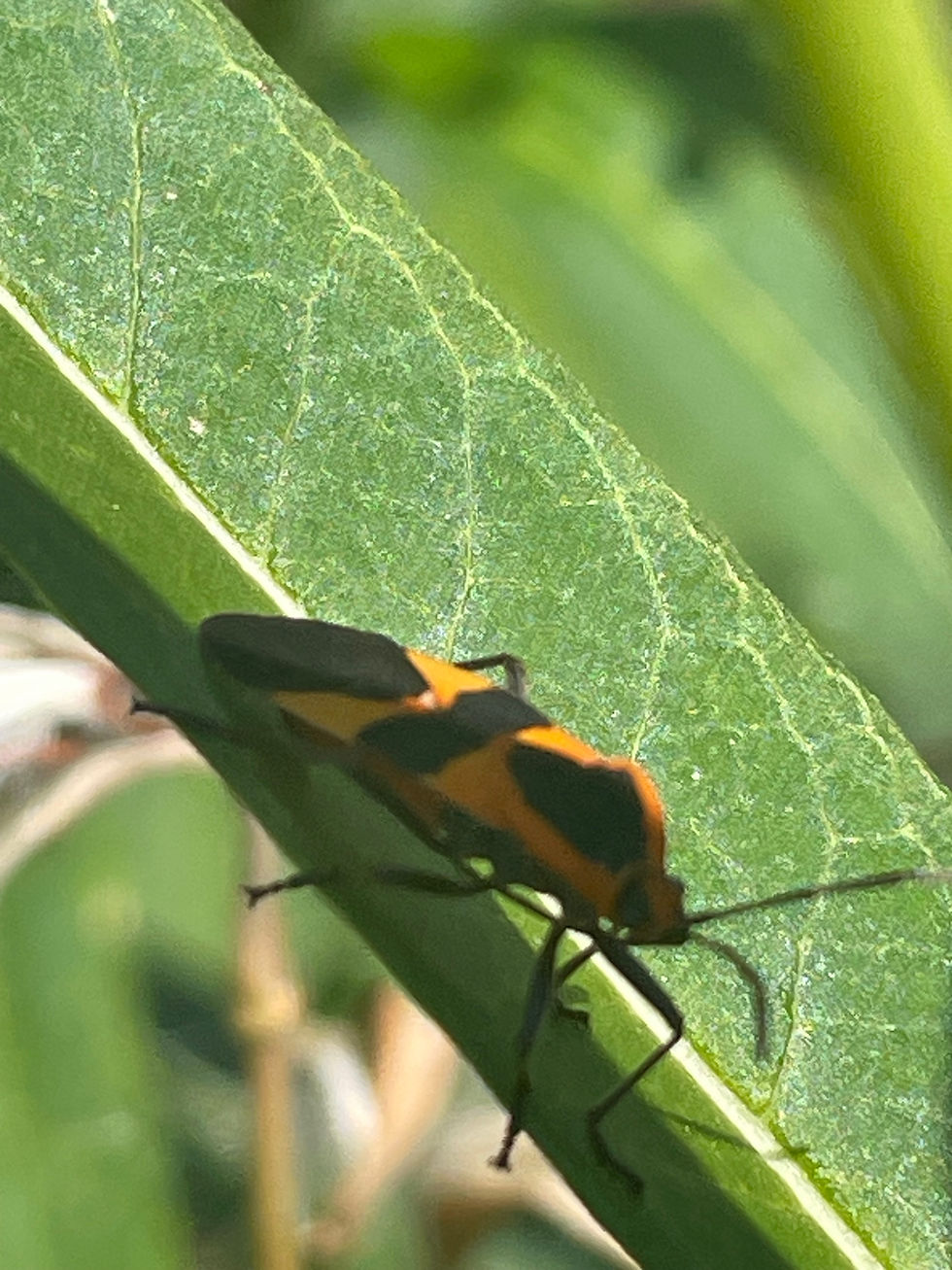
I realized that focusing on butterflies would add purpose to my gardening. I needed to find out how to entice them. Butterflies prefer heavy perfume and nectar that produces carbs because flight demands a lot of energy. To attract butterflies, we must plant what they need to sustain this energy, and of equal importance we must plant the specific host plant required by each butterfly to complete their life cycle. Butterflies enjoy nectar from an array of flowers but they lay eggs on one host plant to complete the life cycle from egg to pupa to chrysalis to butterfly.
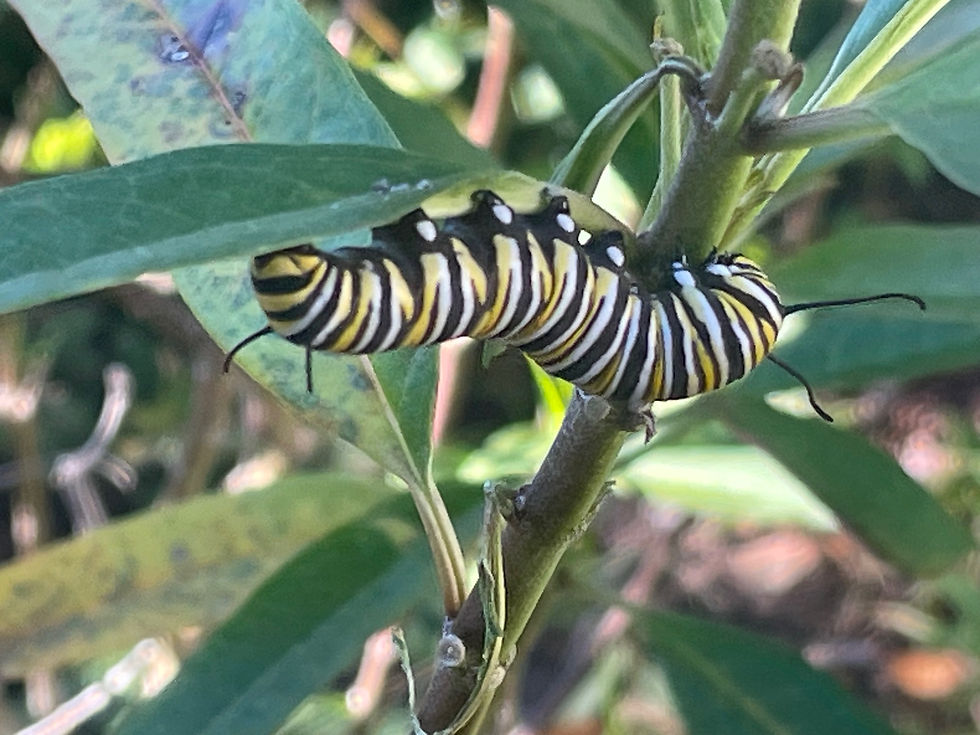
For example, monarchs drink nectar from milkweed, phlox, cone flowers, zinnias and an array of flowers but the milkweed is the only plant on which she will lay eggs. The eggs hatch into a caterpillars and begin feeding on the milkweed leaves. When the larva grows good and fat, it closes into a chrysalis. After a designated period, a butterfly emerges, dries its wings, and takes flight. This happens several times during the summer and then the final hatchling’s job in early autumn is to migrate south for the winter. Vulnerable periods occur in the caterpillar stage when birds take them for their hatchlings and also when newly hatched butterflies are drying their wing so they can fly.

I bought two naturalist guides on butterflies of coastal North Carolina. I selected some butterflies that I would like to attract and support, and then I did a Google search to learn more about the butterfly’s habits and their preferred nectar and host plants. I also did a search of “bang for the buck” perennials to see if these might attract some surprises, and they did. These included coral honeysuckle, Mexican firecracker, and milkweed.

These directives provided good guidance for planting my butterfly garden:
1. Butterflies are cold blooded and require sunny spots, so I watched movements of the sun and staked out the area with morning and afternoon sun.
2. They need wind protection. Luckily, my garden is surrounded by a privacy fence.
3. Eliminate all pesticides in my garden. Check!
4. Think about color. Select majority of flowers from warm color range (red, orange and yellow) or cool colors (purple, blue and white), and cluster the warm and cool colors.
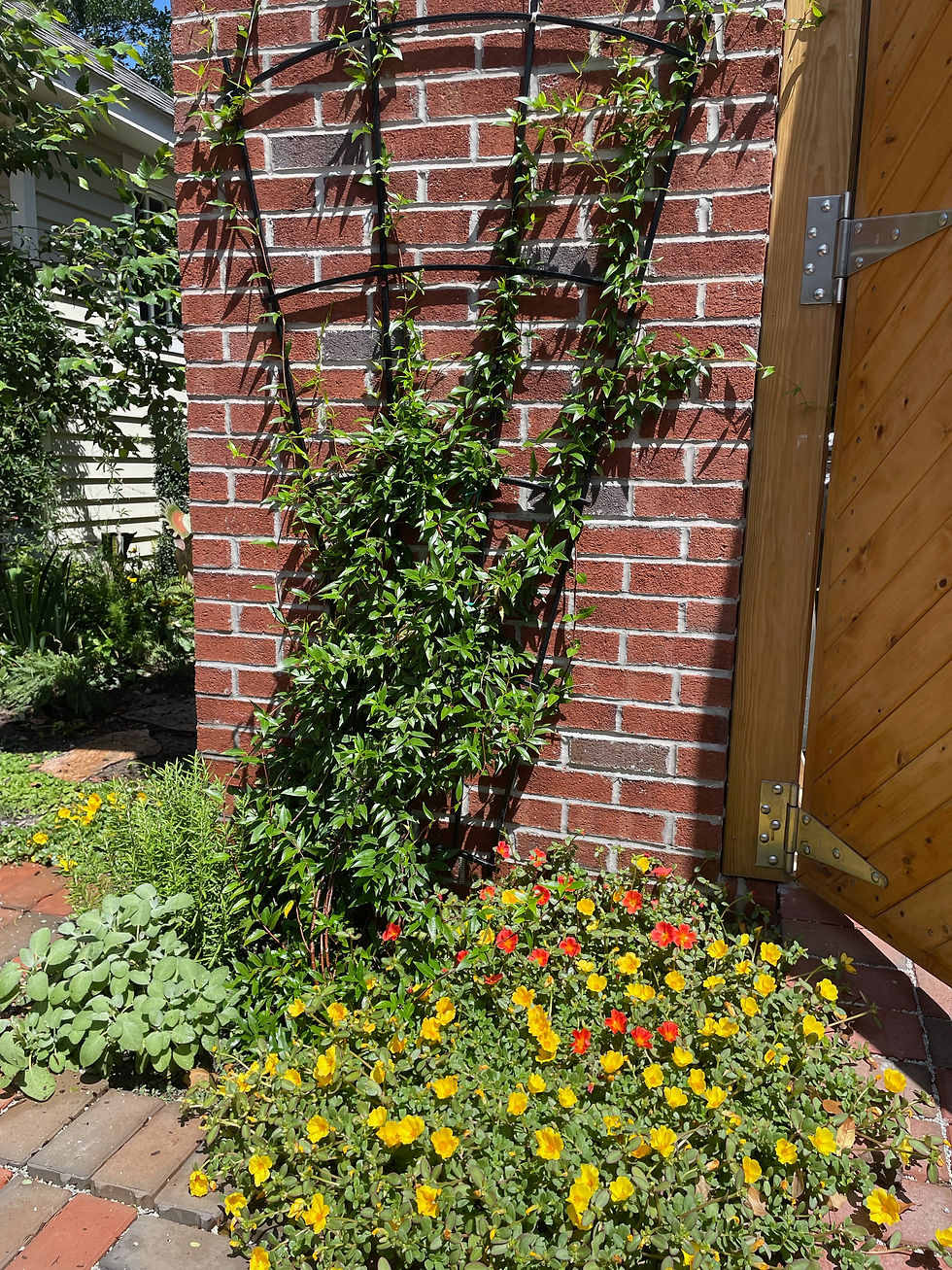
5. Plant a beneficial background. Along my privacy fence I have wax myrtle, yaupon, viburnum, salvia, bee balm, asters, lantana, and native vines like honeysuckle and cross vine. Leave a border of dead leaves and sticks along the base of the fence as some butterflies (morning cloak) caterpillar’s over-winter in the debris waking to eat the host plant leaves in the near vicinity. I created vertical gardens along three walls with pollinator super hosts – Coral Honeysuckle, Carolina Jasmine, passion flower vine, and cross vine.
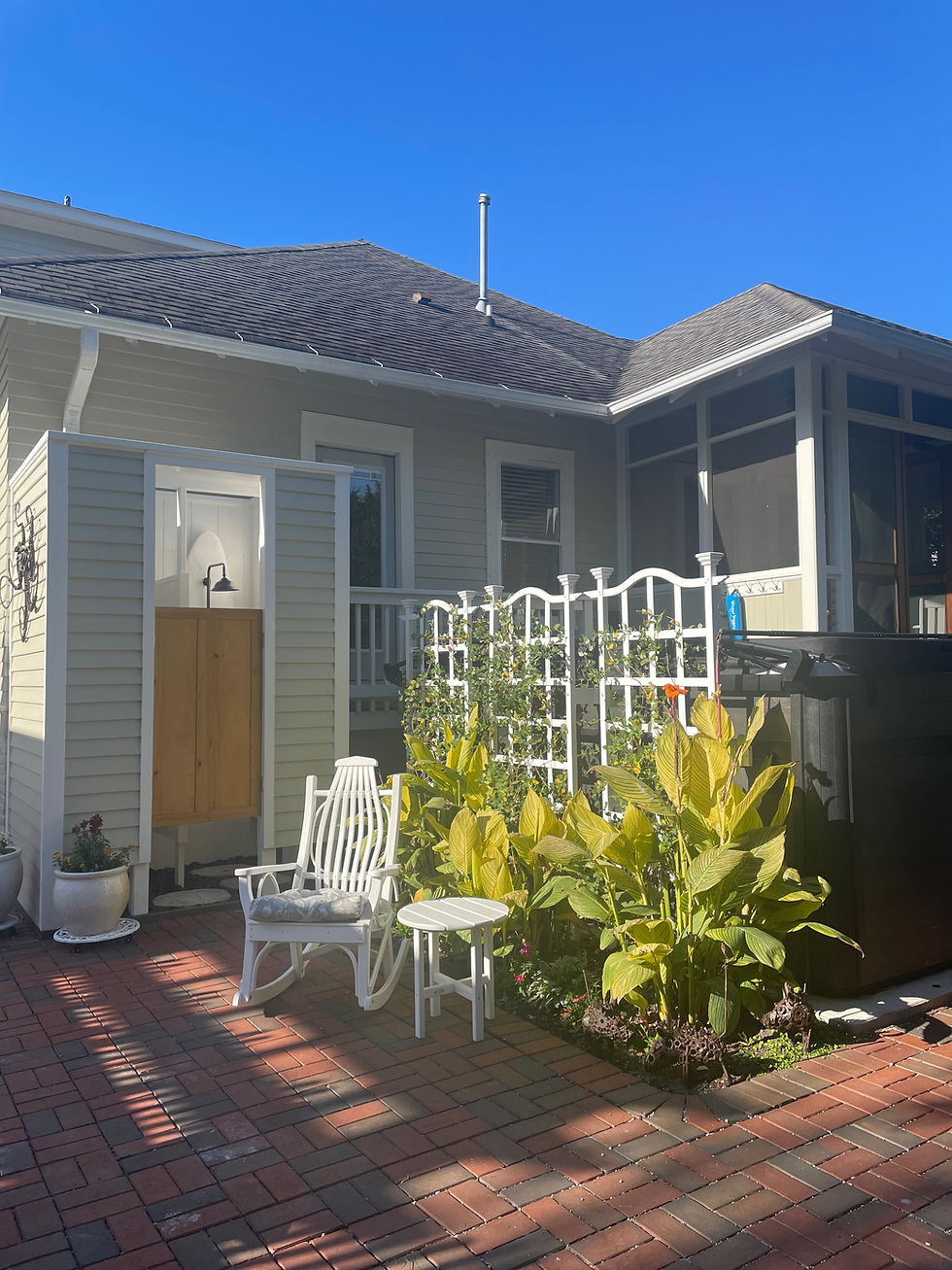
6. The intermediate areas of the garden should include colorful mid-size native perennials planted in clusters of the same species to create masses of blooms. I planned for bloom periods so that there were flowers from April into early November. I learned to deadhead and cut back the perennials to make them bushier and for repeat blooms. This area is where butterfly theatre occurs.
7. The foreground of the flower garden should include long blooming annuals like impatiens, miniature marigolds, profusion zinnias, and sweet alyssum, as well as low growing perennials like dwarf heather. These provide nectar over many months.
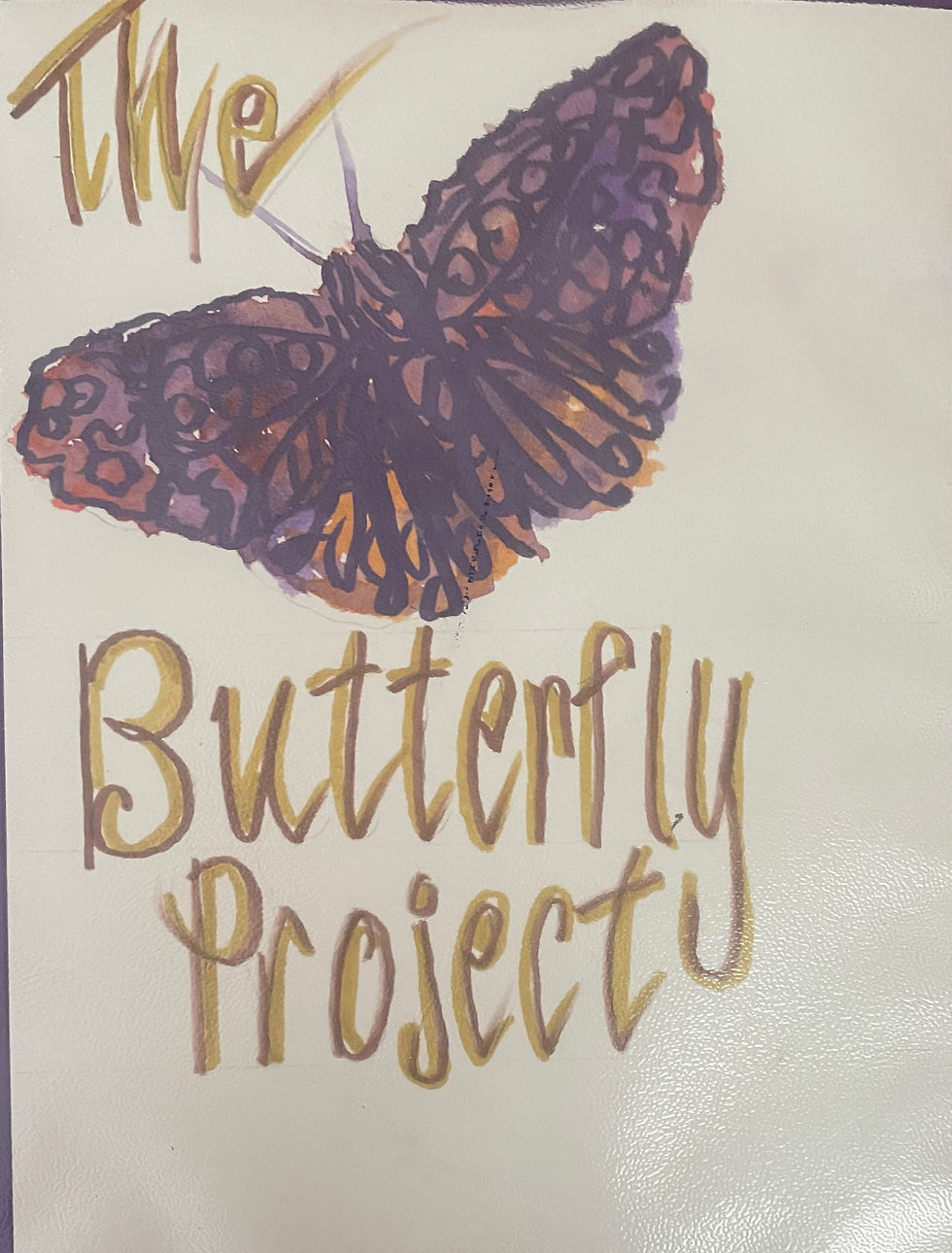
Butterfly Selection
For summer 2023 I selected monarchs, swallowtails and gulf fritillary. I first concentrated on the host plant and then added a variety of nectar plants. My garden attracted an abundance of each type of butterfly. I also had four additional species of butterflies visit my garden. I did some research on these to understand why the surprise butterflies appeared. Perhaps more of them than I was able to distinguish. What a delightful surprise.
My first Lepidoptera species - Monarchs
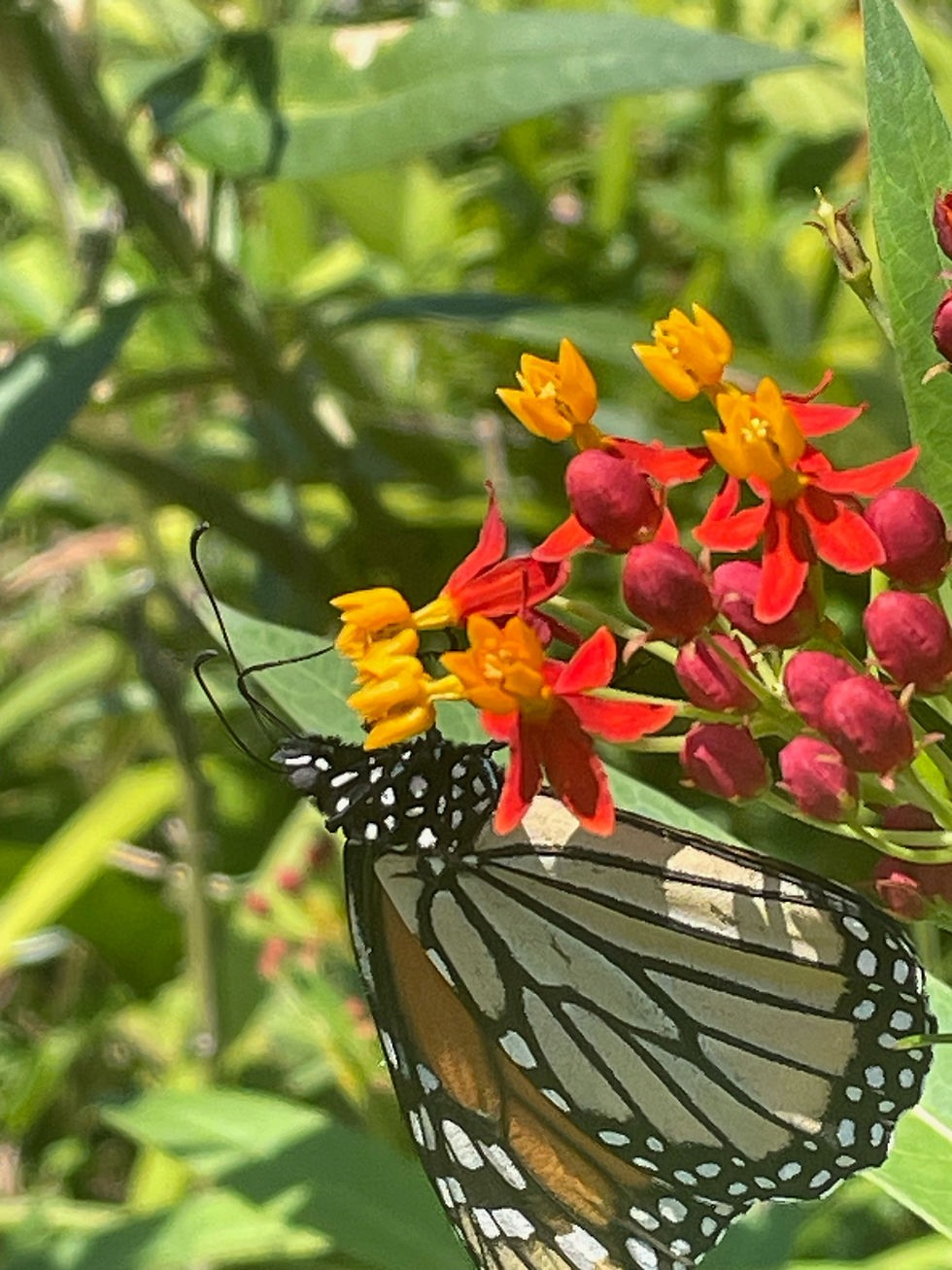
The monarch butterfly starts as an egg on a host plant and goes through three transformations during its life, much like other butterflies. What's different about the monarch is that it is the only butterfly to migrate south for the winter like a bird when its only source of food and survival, the milkweed, goes dormant during the winter.
The adult monarch takes nectar from a variety of plants but only the milkweed provides the essential food for the caterpillar to eat and complete metamorphosis. This cycle repeats itself throughout the summer until the last generation of monarch’s fly south for the winter.
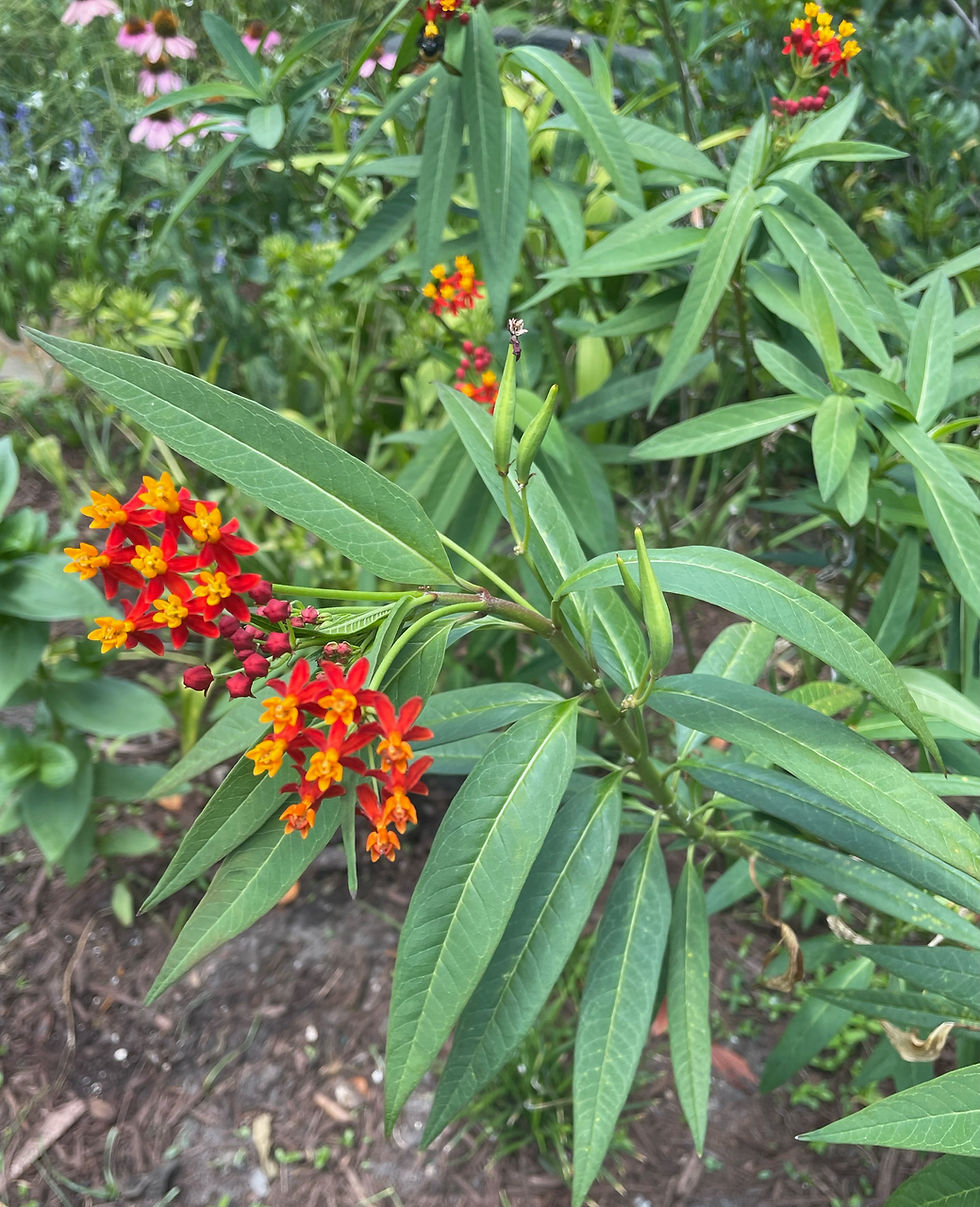
In February or March, the monarch emerges from hibernation and finds a mate. It then migrates north and east and finds a milkweed plant on which to lay its eggs – usually around March or April. It usually takes about four days for these eggs to hatch into baby caterpillars, which become virtual eating machines, consuming large amounts of the milkweed leaves After two weeks, the full-grown caterpillar finds a place to attach itself and begins the process of metamorphosis.
The monarch butterfly emerges from the chrysalis after about ten days. The newly hatched butterfly lives about two to six weeks, during which time it finds a mate and lays its eggs, beginning the life cycle all over again. The final hatchlings migrate south for the winter.
In early October, huge clouds of monarch butterflies make the 2,500-mile trek south where they live in hibernation for six to eight months. Then, in February or March, the entire cycle begins again. Most east coast monarchs spend the winter in Mexico where they have the uncanny ability to find the same Oyamel fir tree where generations before it spent their winters. If monarchs live west of the Rockies, they migrate to Pacific Grove, California and hibernate in eucalyptus or fir trees.
In the 1990s, nearly 700 million monarchs made the epic flight each fall from the northern plains of the U.S. and Canada to sites in the Oyamel fir forests north of Mexico City, at an elevation of 2,400-3,600 meters. More than one million monarchs overwintered in forested groves on the California Coast.
Researchers and citizen scientists estimate that only a fraction of the population remains, monarchs have declined by more than 80% since the 1950s from central Mexico, and by more than 99% in coastal California since the 1980s. Traveling between 50–100 miles a day, the monarch's migratory journey may be 3,000 miles long and take two months to complete.
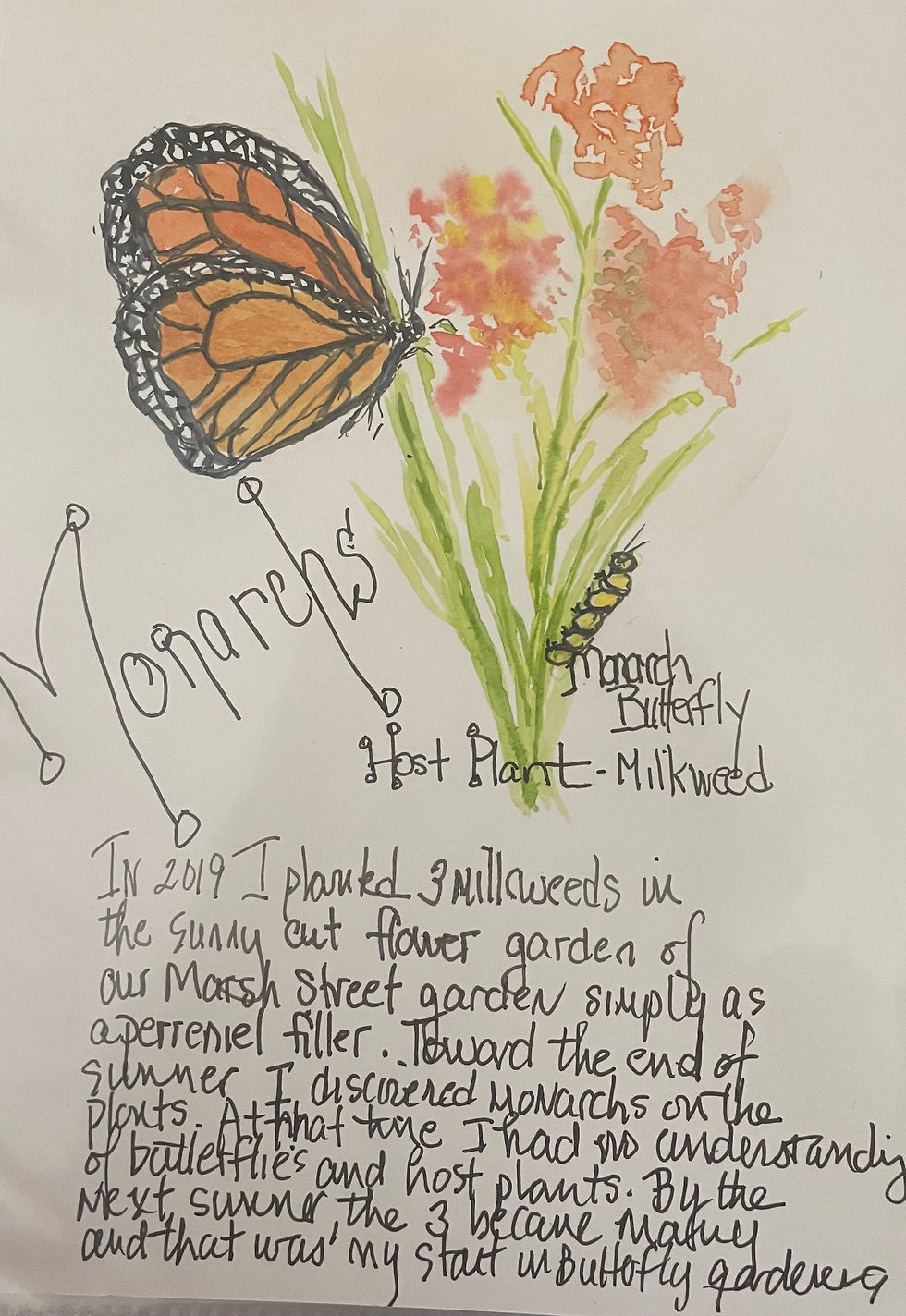
Attracting Monarchs
I created a patch of five milkweed plants of two varieties and the monarchs showed up right away. They enjoy nectar from the milkweed as well but require a variety of flowers for nectar. I planted black-eyed susan, cone flowers, zinnias, salvia, sage. A big patch of phlox already existed and turned out to be most successful in attracting butterflies and bees.
The monarchs were abundant and remained active until the end of October. They disappeared in early November when cooler temperatures set in. I was thrilled when I saw monarch pairs mating, and laying eggs on the milkweed. I was ecstatic to see black and yellow Monarch caterpillars eating the milkweed leaves, but extremely disheartened that they disappeared after a couple days.
Unfortunately, my goal of luring birds to our garden, especially the painted bunting, clashed with my goal to raise butterflies. Most songbirds feed their babies a steady diet of insects, especially caterpillars. One notable study by researcher Doug Tallamy found that one chickadee family fed their babies 350 to 570 caterpillars every day. That's 6,000 to 9,000 caterpillars to raise one family of baby birds.
Next summer I will have to learn how to balance the needs of the birds and butterflies in protecting caterpillars. As George Carlin said, “The caterpillar does all the work but the butterfly gets all the publicity.”
Next summer, I want to grow my skills to distinguish butterflies in the same family, such as Viceroys, painted lady, American lady and Silver Checkers that have similar coloring to the monarchs but different wing designs.
Goal # 2 – Attracting Swallowtail Butterflies

Swallowtail Butterflies of the Papilionidae family include 550 species. This family is found on every continent and include the largest butterflies, birdwing butterflies. The most captivating is the Bhutan Glory Swallowtail. A good reason to go back to Bhutan.
Female Swallowtails are mostly black with increased blue hindwing scaling and marginal yellow spots. No blue on male. Both male and female have a red hindwing eyespot. Swallowtails have forked hindwings and grow 2.5-4.2 inches.
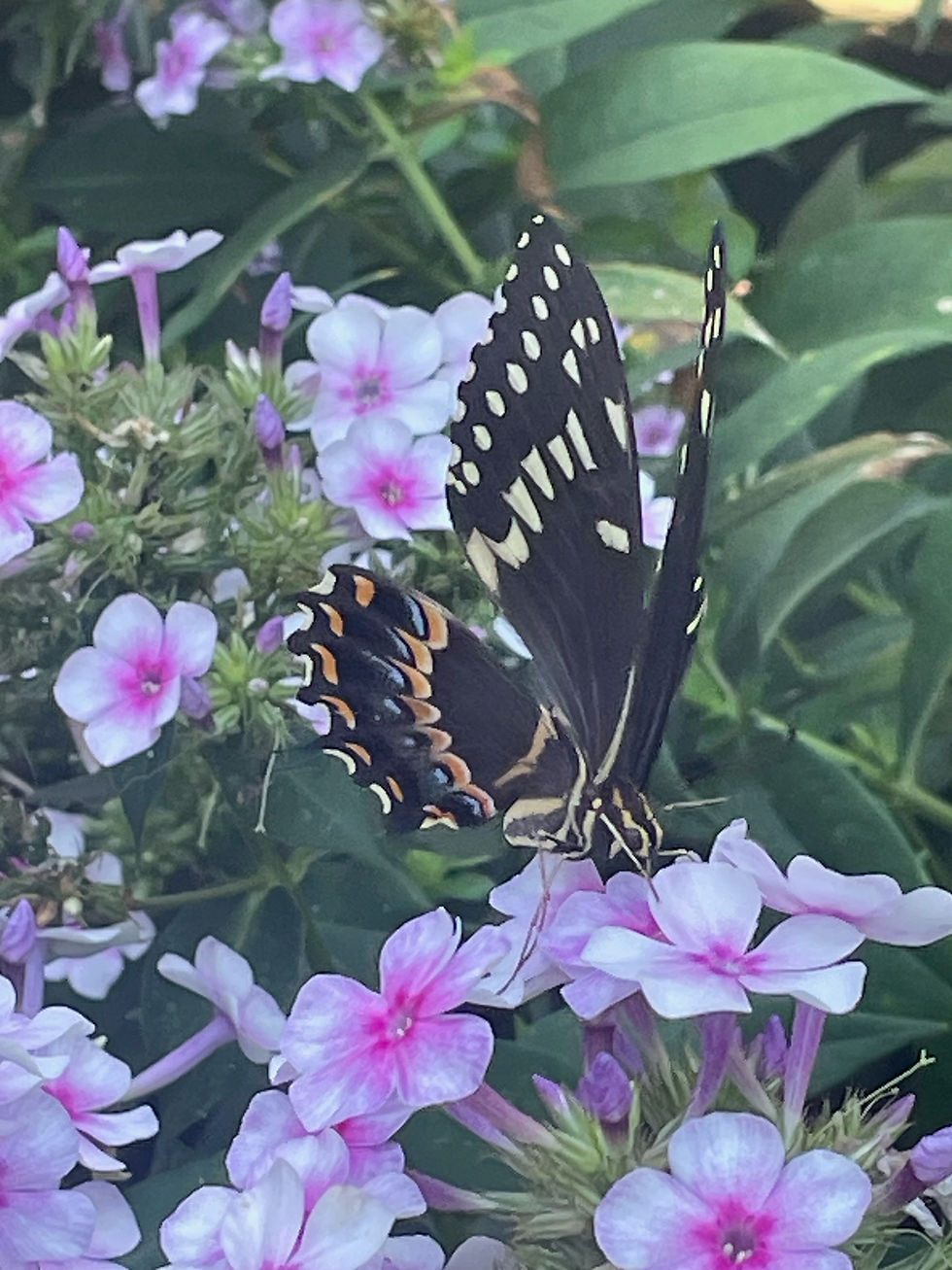
Swallowtails lay yellow eggs on the host plant leaves, wild and cultivated members of the carrot family – dill parsley and fennel – mid-April to mid-October, several broods over a season. The caterpillars (larva) are green with black bands and yellow-orange spots.
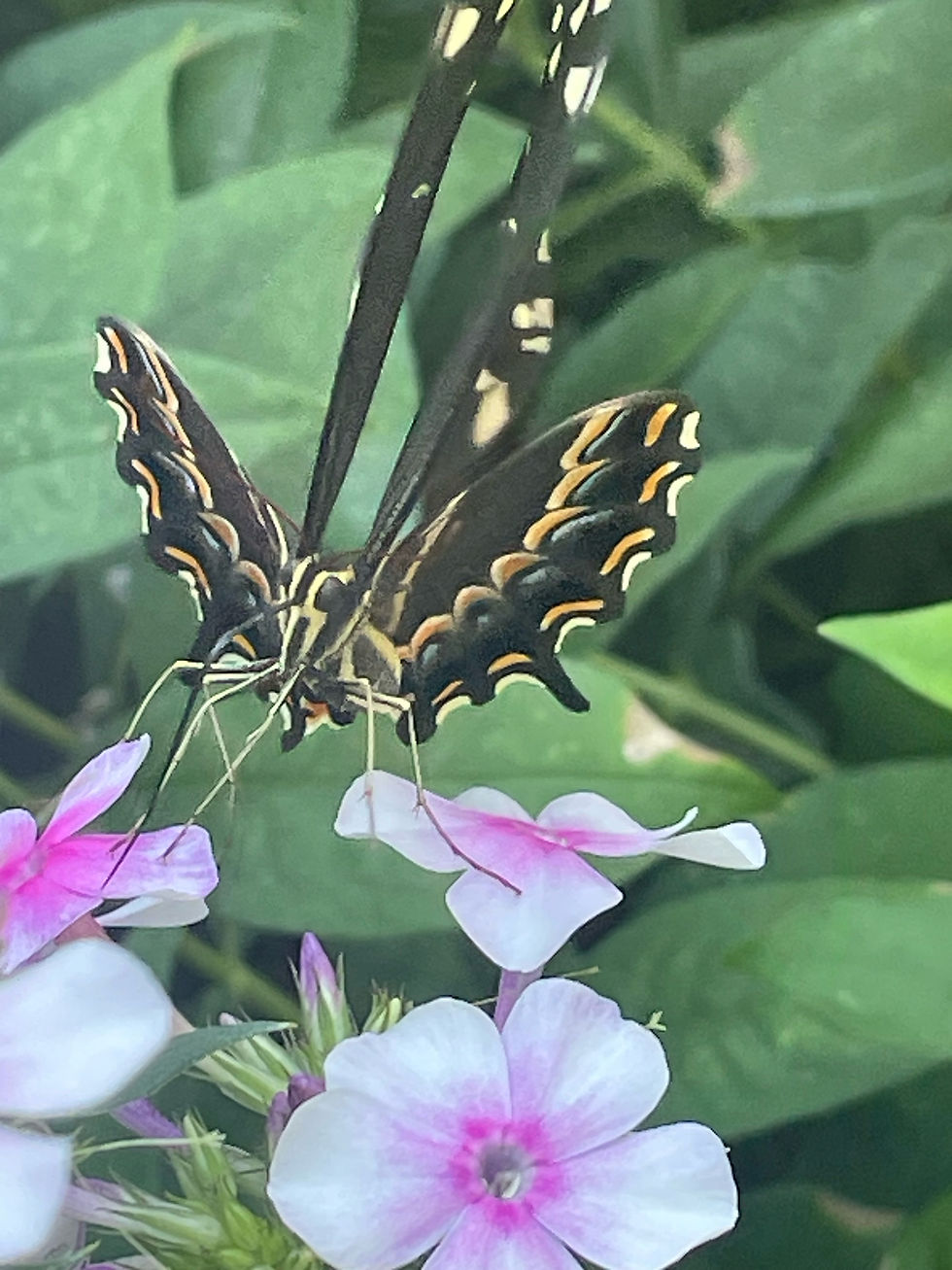
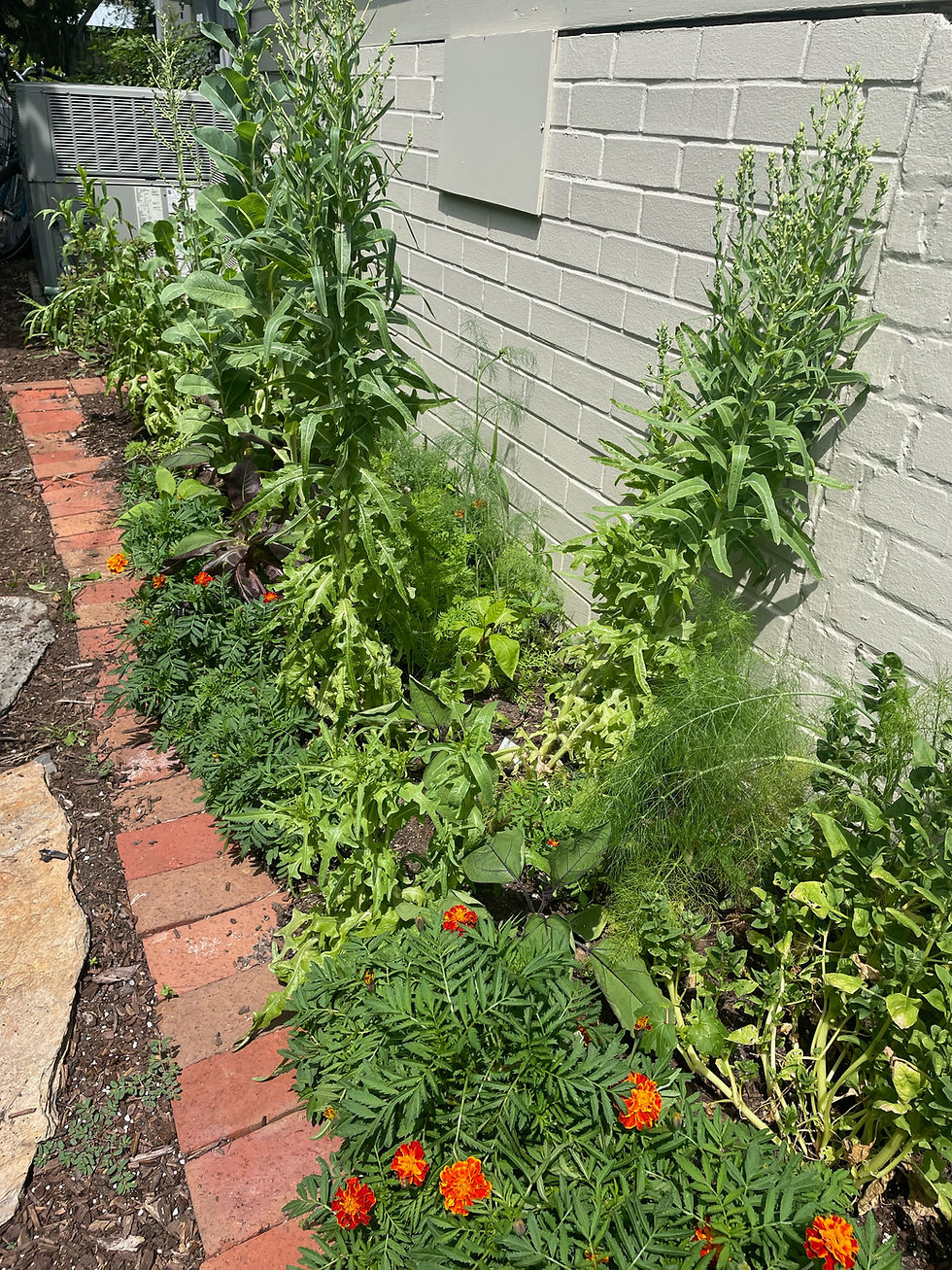
Along the west side of my house, I created a garden lined with bricks for the swallowtails. I planted carrots, fennel and dill just for them. I also planted a large pot of parsley on my back steps along with other herb plants.
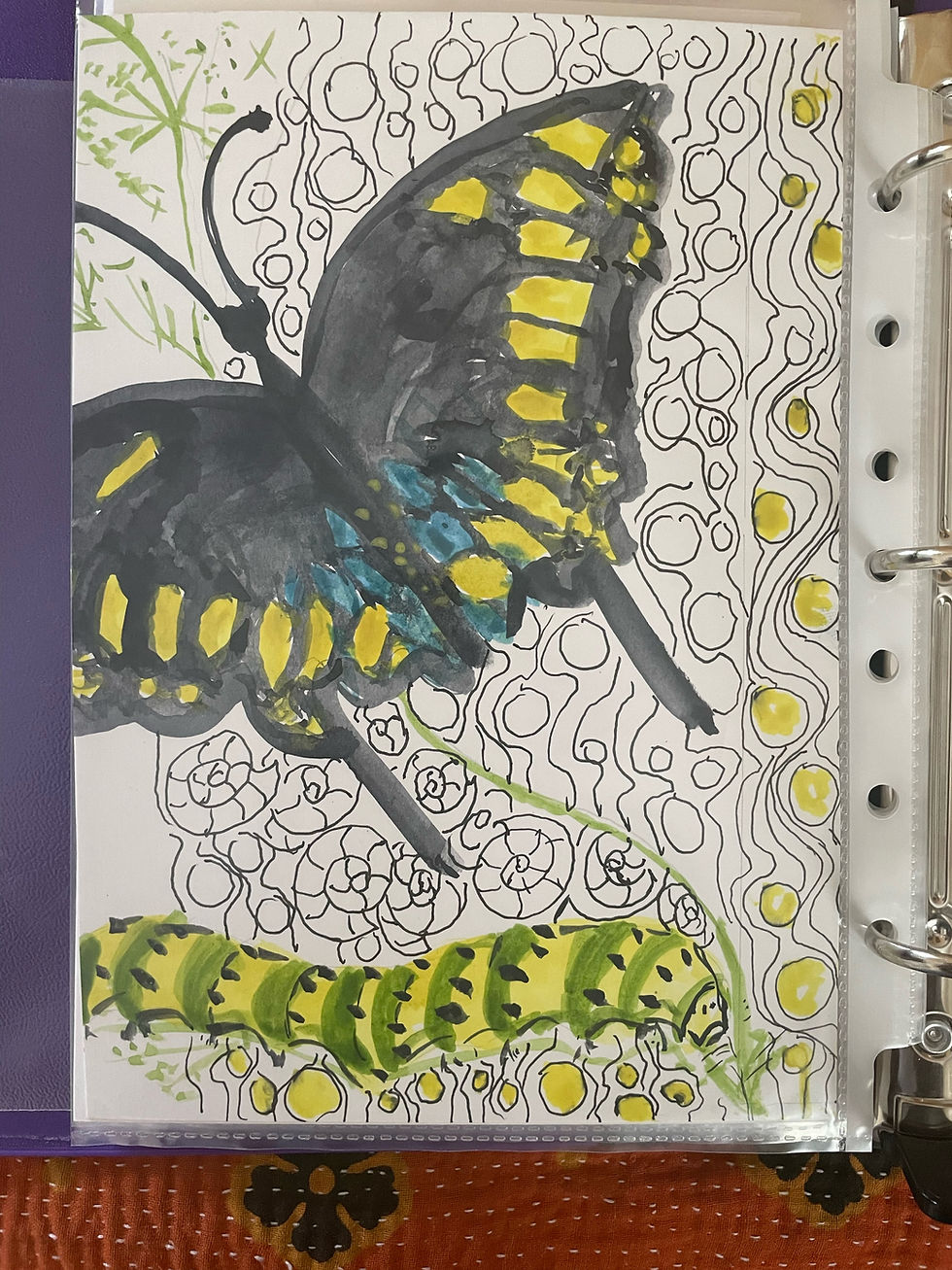
Over the summer I had an abundance of Swallowtail’s taking nectar and mating, but few if any caterpillars survived to produce pupa, due to an abundance of songbirds.
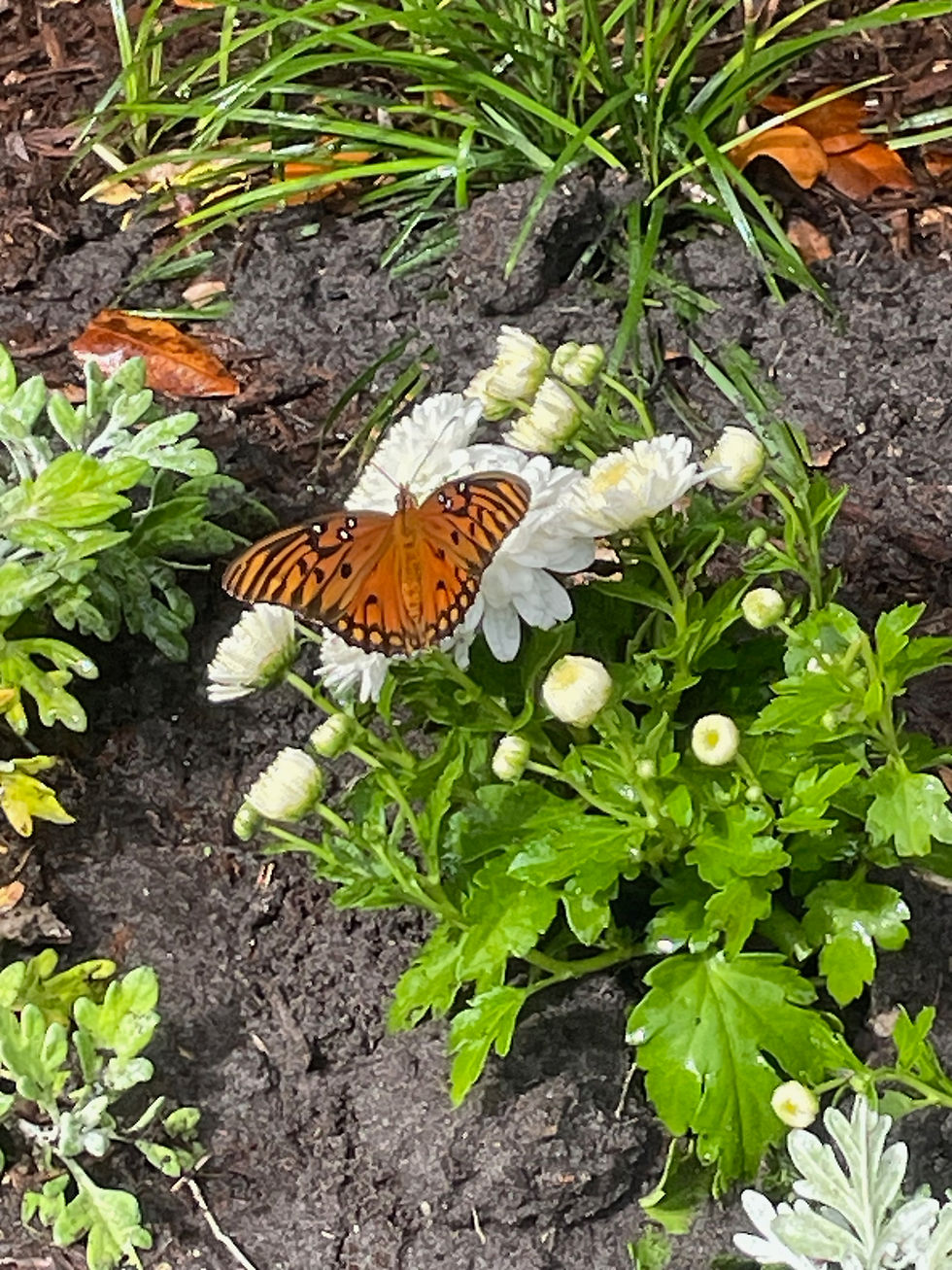
Butterfly # 3 – The Gulf Fritillary
I had already planted violets for Great Spangled Fritillary only to find out that they do not travel to coastal NC. I shifted gears and aimed my sights on the Gulf Fritillary, which also likes nectar from violets but its host plant is a passion vine which I planted.
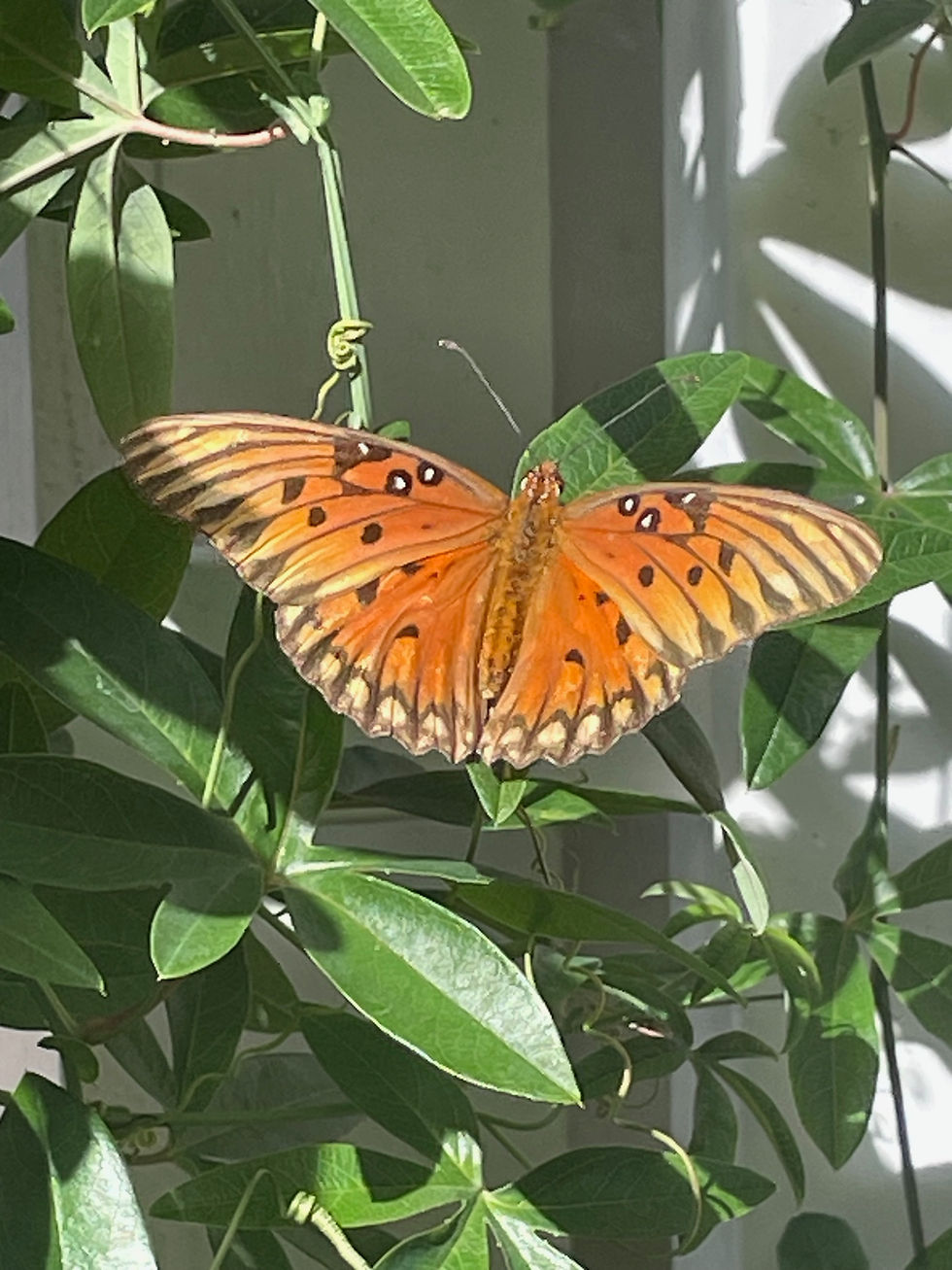
I saw an abundance of jittery, fast moving butterflies with monarch coloring. They flutter their wings so fast it was hard for me to catch one on camera. Finally I realized that their movements were different from Monarchs and also the underwings had silver patches of color. I initially questioned whether they were Gulf Fritillaries because they ignored the robust passion vine I planted. I wanted to say, “Hey ladies and gentlemen, look what I planted for you beside the potting shed porch,” because they ignored my efforts.
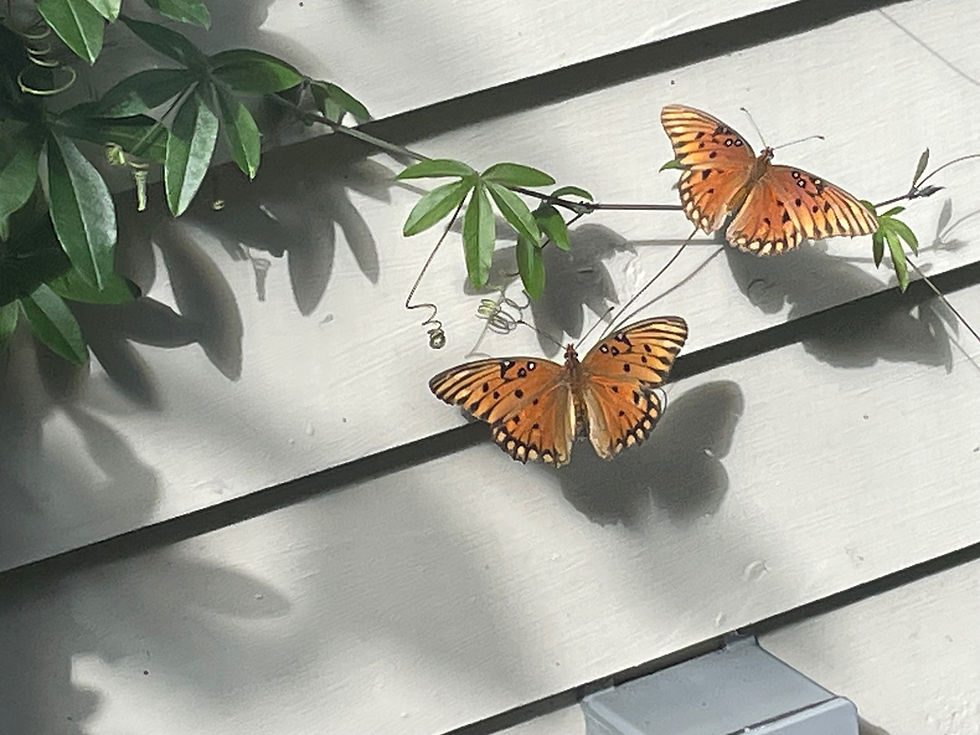

But ,“Wow,” did I learn something about butterflies and their host plant. Late in the summer I began to see pairs of mating Gulf Fritillaries surrounding the passion vine like a halo, and also saw the females lay eggs on the passion vine. Every day I watched for a caterpillar but never saw one. I am hoping that some eggs that were laid deep into the clusters of leaves survived.
Surprise Butterfly Visitors to My Garden
Over the summer I saw an abundance of white and yellow butterflies. I took photos and studied them to distinguish their types. Most likely they were Summer Azures and Yellow Sulphur’s. My neighbor, Lee, grows a vegetable garden on the other side of my fence and has different types of pea and bean vines growing from spring until fall. So, thanks to my neighbor, I had an abundance of these little visitors who also took nectar from my perennials and annuals and laid eggs in his vegetable garden.
My biggest butterfly surprise was a Snowberry Clearwing Butterfly Moth. My local garden shop encouraged me to plant Leo / coral honeysuckle, which is a long and steady bloomer. The flowers are wildly attractive to hummingbirds and butterflies. My vines grew on a wall behind a mass planting of phlox. The phlox attracted swarms of bumble bees of different types and sizes. But one creature gave me a double-take. It appeared to be a huge yellow and black-striped bumble bee with large wings as stunning as a leaded glass window, taking nectar from the honeysuckle in two locations in my garden, as well as from the Mexican Cigar plant and the phlox. Not a bee at all!
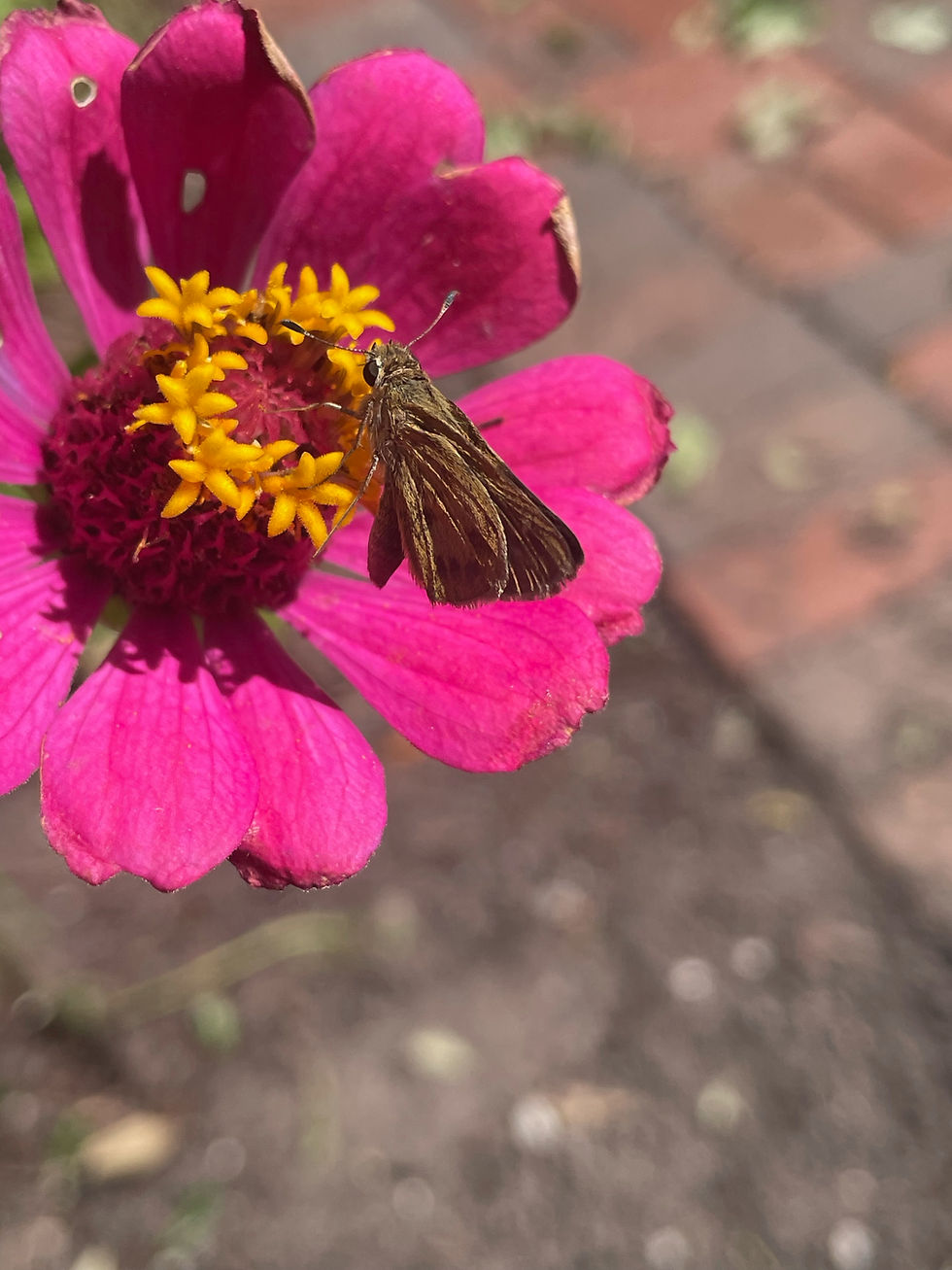
Toward the end of the season, I saw plenty of little brown skippers. They flitted and flew so quickly that they were difficult to photograph. I read about skippers and discovered that a rare Crystal Skipper lives on the barrier islands from Swansboro to Beaufort. It was only recently discovered and butterfly enthusiasts travel distances to see it and complete their Butterfly Life List. I was excited and hopeful that these might be Crystal Skippers.
I studied them long and hard. Each skipper in my garden had fluorescent green along its upper body and base of wings. Finally I found photos that matched my skipper and discovered that it was a Long-tailed Skipper.
Photo from: https://butterflies and moths.org
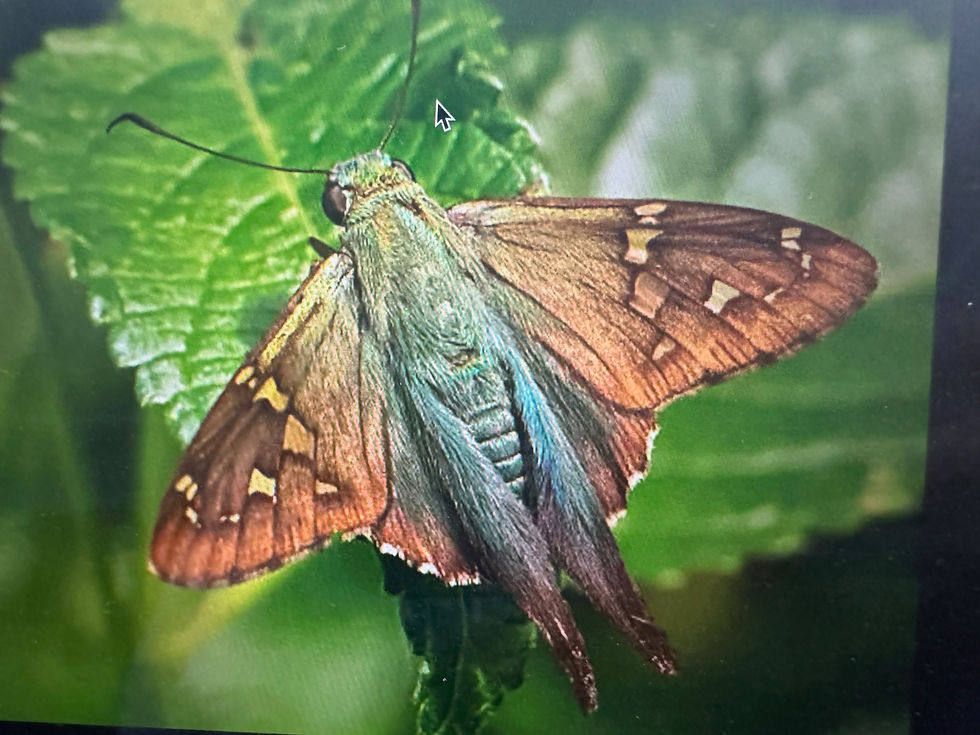
A favorite past-time over the summer was standing in my perennial bed and watching butterflies. I did this coming and going from my potting shed or while watering plants. Weeding took on added purpose, providing me with a sustained amount of time watching butterfly visitors.
I realized that in future I should dedicate more time for standing and watching. Only then will I learn to distinguish butterflies within the same family and train my eyes for eggs and larva. Only then might one touchdown on my hand and say, “Thank you for lunch.”
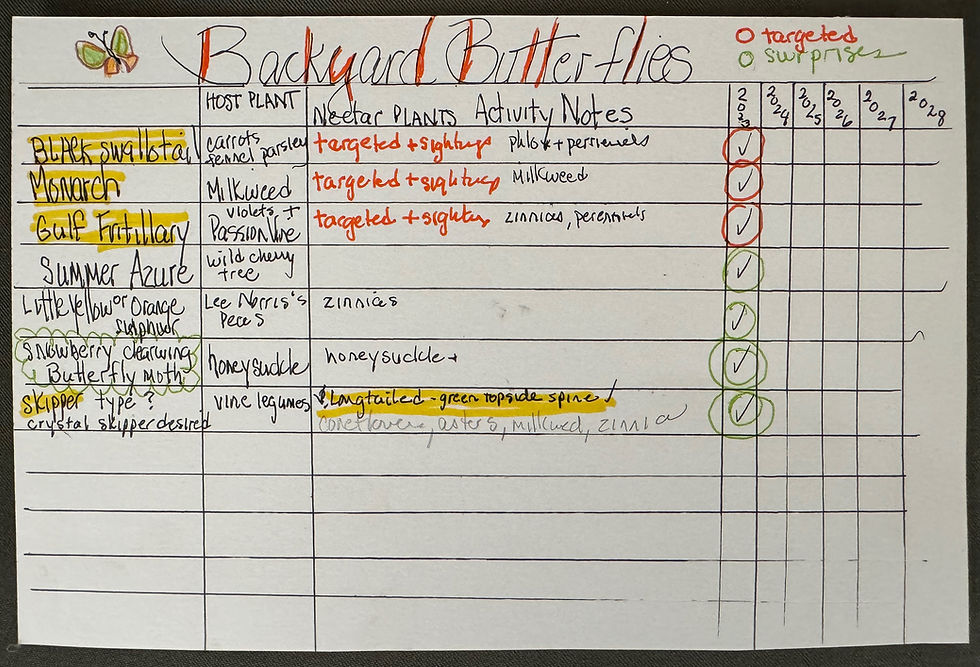
In many ways, poetry led me to butterflies, so I will close with a butterfly poem by my favorite poet, Emily Dickinson.
Two butterflies went out at noon
And waltzed above a stream,
Then stepped straight through the firmament
And rested on a beam;
And then together bore away
Upon a shining sea,
Though never yet, in any port,
Their coming mentioned be.
If spoken by the distant bird,
If met in ether sea
By frigate or by merchantman,
Report was not to me.
Emily Dickinson
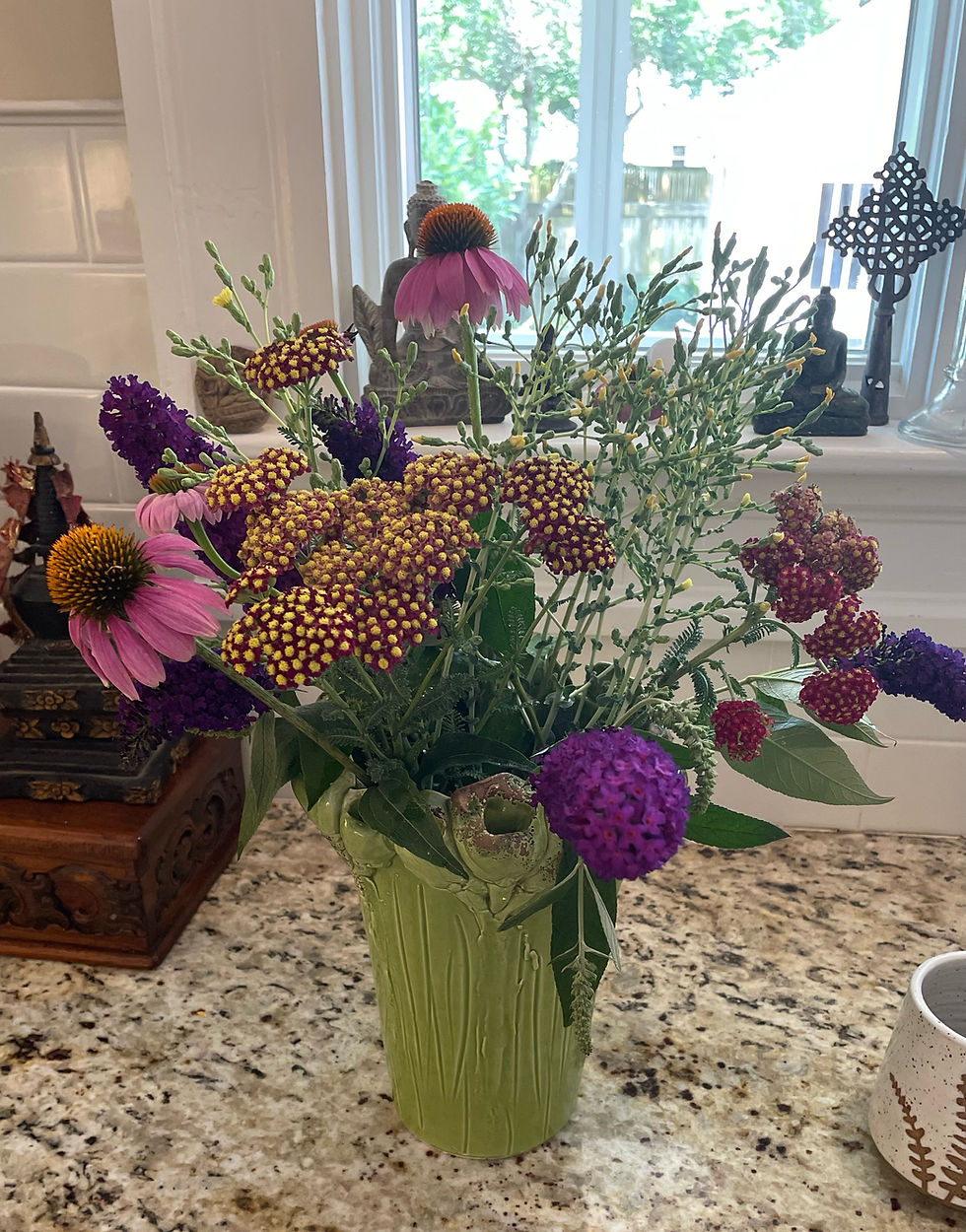
This blog was written in December 2023 by Deborah Llewellyn.
Notes:
All photos taken by the author except for the Long-tailed skipper, loction noted.
All drawings are from author's garden and butterfly journals.
Below are three poems I wrote that are mentioned in this story.
Monarchs Calling
I traveled to Mexico to paint
Bougainvillea's cascading over cracked stone walls
A parade of colonial homes
Standing like onlookers
Lining the steep ascent to the tiny chapel
Its cracked bell silent from age and ivy
While in the town square below
Shopkeepers lean casually against door frames
Crowned with early spring flowers
Bidding artists to settle in a splash of shade
And capture the scene for eternity
Sidewalk cafes, balloons, and flower carts
Encircling the town square of Parroquia de San Migel
Like a wreathe
In transit I met a traveler flying to Michoacan
wearing a uniform of experience and clutching
a picture book of Monarchs as if in prayer
Cloaked in a bohemian shawl of azure and plum
That hung from her raised arms like Lepidoptera wings
She described the miracle of the monarch and her quest
To witness thousands of endangered flutter-byes
Roosting in the same Oyamel fir tree as generations before
Folding their tired wings to rest in dormancy
After a 3,000-mile journey
The only butterflies to migrate like birds
Fleeing northern winters
Like clockwork, to survive
I'll sit below the tree she said
Gazing up at globes of orange and black
As the weary creatures sleep, and wait
For their genetic clock to electrocute the tree
With mating monarchs listening
To a distant song of milkweed shoots
Cracking the hardened winter soil
Softened by gentle spring rain
Chanting your dinner is served
The nursery is ready
Come home to lay your eggs on our slender leaves
Where hungry caterpillars can hatch and gorge,
Form a chrysalis, and emerge once more, a butterfly
Bear witness, bear honor
And so the traveler asks
Why I travel to San Miguel de Allende
To paint rose-colored stones
When with a shift of flights
She'll show me a canopy of miracles
To capture with my brush
Another time, I said
Don't wait long she warned
Populations dwindling, now endangered,
Too much concrete, not enough milkweed
I went on my way, but haunted
By my journey's lack of relevance
In a grand web of life on the verge of collapse
For want of milkweed.
Swallowtail Midwife
My friend, the swallowtail midwife
Paints on canvas and with her sight
I met her by an easel in front of my house
Under a floppy hat
When I noticed the stars in her eyes
And bid her to my back garden
Tangling her into my web
To capture something, not sure what
Maybe serendipity
And so it comes, over the years
The unexpected gifts she leaves
A painting of the room where she slept
Or my favorite place to sit
Honoring the beauty of my food with photos
Whisking the peach pie to the porch railing
And a backdrop of flowers
Taking time to be dazzled before dining
And out of nowhere she pulls from the sky
A perfect approach I've been longing to find
To tell the story of me
No small things come from
Gathering a stranger from the street
With stars in her eyes
And then as if enough,
I told her of a rare book I longed to have
And she said I have that book
I will give it to you
And when it arrived the joy erupted
And I called her in delight but in mid-sentence
She made me hold the line
To photograph her birthing room
A kitchen filled with branches of fennel
Caterpillars folding into chrysalis
And chrysalis unfolding into swallowtails
Slowly, somewhat distracted by magic
She tells the story of her fennel garden
Every year planted for the swallowtails
A butterfly nursery, and as I wait
The swallowtail unfolded its wings
Wet, stunned and vulnerable
My friend sat in veneration
Then carried the hatchling into the night
And watched it fly away
Wishing I could see her quiet jubilation
Dazed again from her forever unexpected
I wander out into my garden under the stars
To my pot of dill with one fennel plant
Bought accidentally
Left for a reason I now know why
Another gift
From the painter, the butterfly maker
With stars in her eyes.
Butterfly Lessons
The Great Spangled Fritillary
In a spark of fire
Flutters over the garden gate
Enraptured
Long tubular flowers
Sweet nectars of summer
Captured
the flutter-by
To a paradise that beckons an easy feast
Joe-pye weed, trumpet vine, and
Honeysuckle that tastes like wine
Stay for a time with so much to dine
But take heed lest you gorge
and copulate
In splendor for a season
Seduced
By a repast of debauchery
Missing your true compeer
The delicate purple violet,
less showy, more dear
Left frantically searching,
With egg sack engorged
Foraging in the dark moist soil
For this one and only flower's foliage
An egg and caterpillar nursery
curled in a browned autumn leaf
That hibernates and wakes to feed
On tender, spring violet leaves
Where a pupa forms, a Fritillary is born
Fanning wet wings, then taking flight.
Salvation for posterity in sight
But frittered away in my garden of delight
Bereft of magisterial violets






































Kommentare